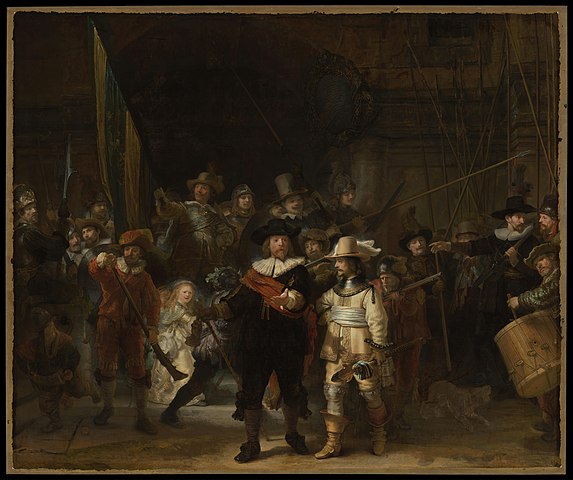
Name: The Night Watch
Artist: Rembrandt van Rijn
Date Painted: 1642
Period: Baroque
Dimensions: 363 cm (h) x 437 cm (w)
Medium / Material: Oil on Canvas
Current Location: Rijksmuseum Museum, Amsterdam
Introduction
“The Night Watch” officially titled “Militia Company of District II under the Command of Captain Frans Banninck Cocq,” is one of Rembrandt van Rijn’s most famous and ambitious paintings. Housed in the Rijksmuseum in Amsterdam, this masterpiece is celebrated for its colossal size, complex composition, and innovative use of light and shadow. It marks a departure from the traditional static militia group portraits of the time, infusing the genre with dramatic energy and realism.
Composition and Subject
The painting depicts Captain Frans Banninck Cocq and his lieutenant, Willem van Ruytenburch, leading their militia company. Unlike the orderly and static formations typical of group portraits, Rembrandt arranged his figures dynamically. The composition appears to capture a moment in time, as if the company is mobilized into action, moving out of the canvas towards the viewer. This sense of motion is enhanced by the varied poses and expressions of the figures, creating a lively and engaging scene.
Use of Light and Shadow (Chiaroscuro)
Rembrandt’s use of chiaroscuro, the contrast between light and dark, is particularly striking in “Night Watch.” He masterfully directs attention to the central figures of Cocq and Ruytenburch through a spotlight effect, while the surrounding characters are rendered in shadow or partial light. This technique not only emphasizes the hierarchy within the group but also adds depth and volume to the composition.
Color and Detail
Despite its name, “Night Watch” was not intended to depict a nocturnal scene. The darkening of the painting over time led to this misconception. Recent cleanings have revealed a much brighter scene, with a rich palette and detailed textures that showcase Rembrandt’s skill in rendering materials like metal, fabric, and flesh. The varied attire and weaponry of the militia men provide a glimpse into 17th-century Dutch life and military equipment.
Symbolism and Interpretation
“Night Watch” is rich in symbolism. The young girl in the background, for example, is often interpreted as a mascot of the company, adorned with the militia’s emblem. The chicken hanging from her belt symbolizes the Arquebusiers civic guard group, also known as the Kloveniers, and the claws represent their claws in the city’s defense. Rembrandt’s inclusion of himself in the composition, seen barely in the background, suggests his connection to Amsterdam’s civic life and his pride in this commission.
Innovations and Legacy
Rembrandt’s innovative approach to the group portrait transformed a conventional commission into a vivid and dramatic scene, full of life and complexity. He challenged the norms of composition, lighting, and narrative, creating a work that feels modern and engaging. “Night Watch” not only exemplifies Rembrandt’s mastery of painting but also his ability to convey movement, emotion, and depth.
“Night Watch” remains a pinnacle of Rembrandt’s career and a cornerstone of Dutch Golden Age painting. Its influence extends beyond its historical context, continuing to inspire artists, scholars, and viewers with its technical brilliance and emotional depth.